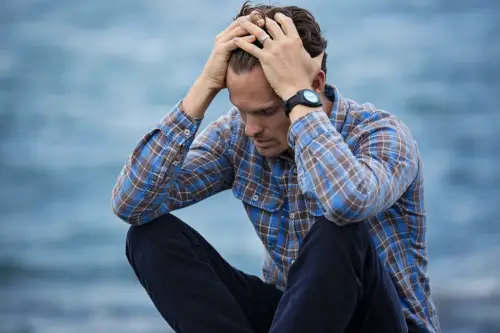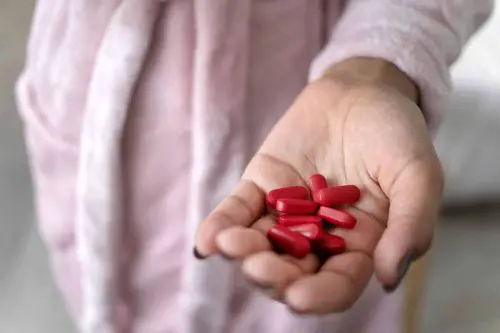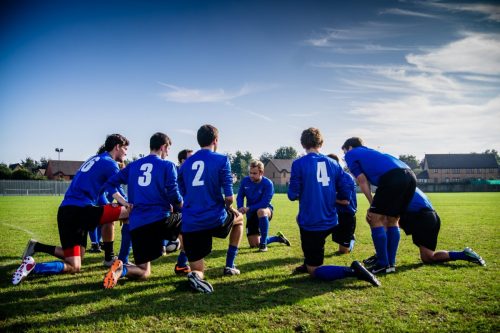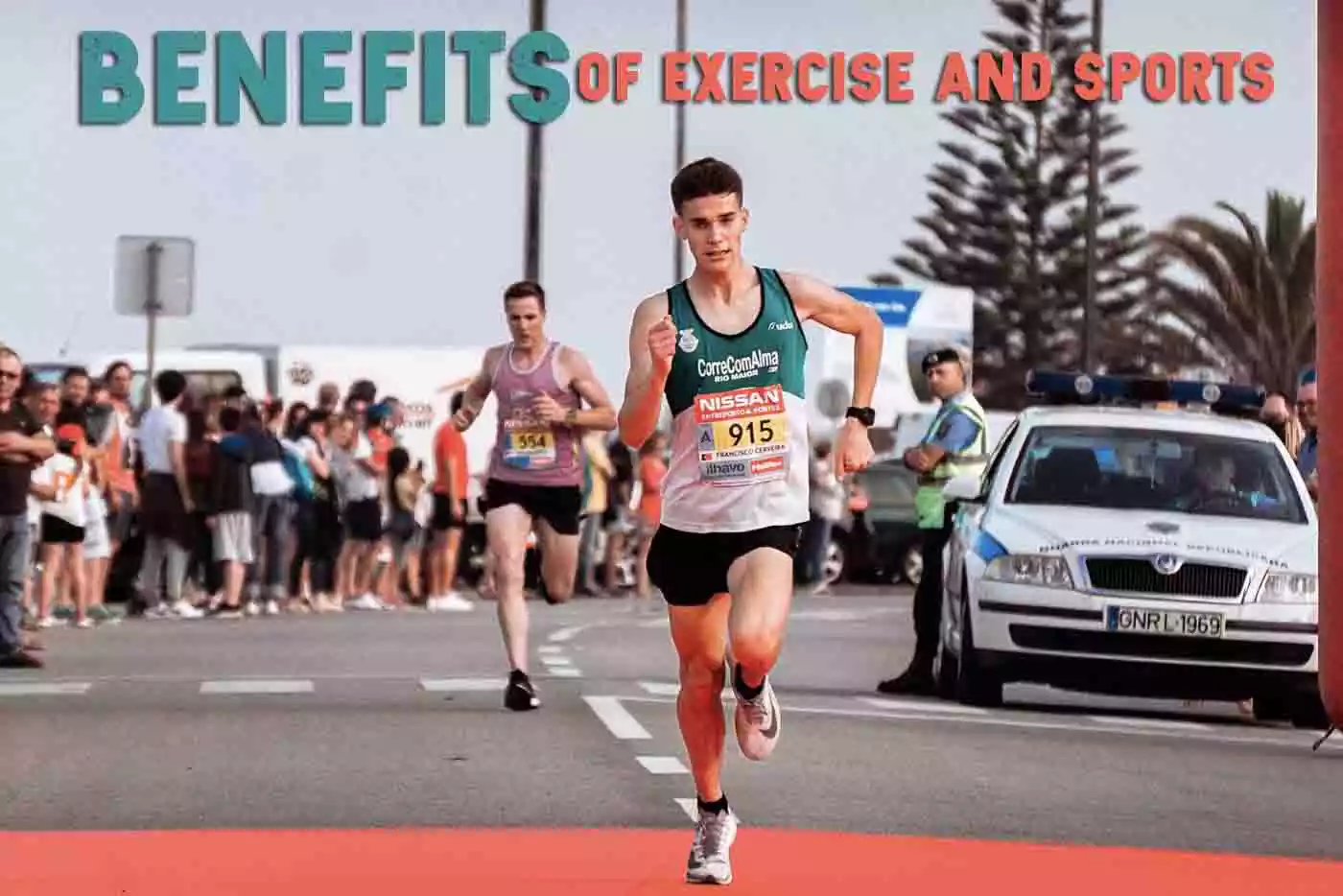Welcome to our list of the top 9 physical, mental, and social benefits of team and individual sports. This overview includes the involvement in both sports and exercise in general.
Actually, exercise is the real benefit for the first 7 items on our list, but one of the best ways to get that exercise is through sports.
When I was in high school and college, it was nearly impossible to get me to jog for 2 kilometers on a track, road, or treadmill, but throw me into a basketball game where I run 5 or 6 km during the game, and I wouldn’t even notice the pain!
When I first thought of writing this article, I noticed myself shaking my head with a bit of a smile. Why?
Well, at first I thought that EVERYONE would be so very aware of how obvious the multiple benefits were, of being involved in any physical activity.
That may seem obvious for many, but I assure you that it is in fact NOT quite so obvious to others. That’s why I knew it needed to be written even though to me I felt as though someone would call me “Mr. Obvious” after reading it. Let’s see!
1. Boosts Confidence Levels
2. Improves Mood
3. Improves Concentration / Academics
4. Removes stress/Depression
5. Improves sleep habits
6. Maintain a healthy weight
7. Fights Disease
8. Social and Societal Benefits via reduction of crime
9. Teamwork Skills/ Leadership Skills and Teaches Discipline
1 – Sports Helps Boost Confidence Levels
No one can deny that if you develop better than average physical and mental qualities, you’ll gain a huge psychological advantage over nearly everyone else.
You’ve seen the guy with abs and a great physique on the beach or at the gym. In most cases, he’s got friends that like to hang around him, and his girlfriend/wife is definitely a 9 or 10! You get the idea.
In all my years in competitive collegiate sports, I’ve noticed that the best athletes (or at least the guys with the best physique) tend to be the ones that are given leadership roles (if only unofficially) whether they like it or not.
They ARE role models. If that type of attention doesn’t boost self-confidence, nothing will I’m afraid. This principle works the same for women and children.
Hopefully, as far as children are concerned, the dynamic is a little less “mature”, and confidence is derived from knowing they’re not the absolute worst at something.
As a child and adolescent, I was on the verge of a self-confidence breakdown. True story! At 13, I was super skinny, had tons of acne, only had old, second-hand clothes, and I was barely average in academics.
Oh, and did I mention, I wasn’t exactly great-looking either. One could argue I had very little going for me.
The ONLY reason elementary school and especially high school were bearable for me, was the fact that I could cream anyone in basketball (one-on-one, free throws, skills, etc.).
I literally had no equal in elementary school. In high school, I had a nemesis (also named PETE) who was better than me in basketball, but I was a close second, with no one even close in third place!
That Pete went on to play for Canada’s largest University and the Canadian National Men’s Basketball Team!
I was respected for my abilities, even though in and of themselves, those abilities were not exactly necessary life skills. It’s like being an International Rock Star and being good-looking – they don’t really help our society, but people put you high on a pedestal!
2 – Improves Mood
According to an in-depth study by Kathryn Fritz of the Department of Kinesiology at the University of Georgia, the overall mood of young men with ADHD was significantly improved through regular exercise.
Her conclusion was that a 20-minute session of moderate-intensity cycling (as an example) increased feelings of energy while reducing feelings of fatigue, depression and confusion.
The study was done with 32 young adult men (aged 18-33) with symptoms of Adult ADHD.
What we found VERY encouraging is that this study was a short one with only one session of exercise.
We at sportconsumer.com are not doctors or scientists, but we’re not dumb either.
We can extrapolate and see how continued exercise over the course of weeks, months and years would only increase beneficial outcomes when it comes to mood enhancement … without fake drugs. We like that!
3 – Improves Academic Performance
I’ve suspected this for many years but I didn’t really have any solid, scientific evidence for it!
As an athlete in high school, I could see around me that nearly every athlete on my teams in volleyball and basketball was above average academically speaking.
I knew my own abilities academically were only average, but when I graduated high school, I received an academic achievement award that was completely unexpected! Coincidence? Maybe.
However, according to Dr. Jesper Fritz, a member of the Clinical and Molecular Osteoporosis Research Unit, Department of Orthopedics and Clinical Sciences, Lund University, 20502 Malmö, Sweden, there’s some science to the connection of sports and academics.

In an extensive study done at Lund University with 338 children over 5 years, the overall findings were that physical activity in children and teens increased academic scores and post-secondary eligibility rates significantly.
Those in the study were more physically active than the control group. They were physically active for 40 minutes per day.
The control group only had 60 minutes per week of physical activity. The rates of university eligibility (higher grades) were significantly higher than the control group overall.
4 – Decreases Stress and Depression
In the same study as cited in the previous point, it was outlined and postulated that many previous official, scholarly studies have found a VERY strong connection between being physically active, and having low incidents of depression and also lower stress levels.
The research to indicate this is overwhelming. Here’s a point of conclusion from the Lund University study:
There are numerous potential hypotheses that may explain the association between increased PA and improved school achievement [15,29,30]. Some studies infer that PA may have direct positive effects on the nervous system by increasing brain volume, blood flow to the brain, synaptic plasticity, as well as promoting the formation of nerve cells, all involved in different aspects of perception, cognition, memory, and attention [31,32,33,34]. Other studies suggest that PA has positive effects on psychological parameters such as self-esteem, motivation, social engagement, and communication [12], all of importance for learning outcomes.

Another study on Clinical Depression by Lynette Craft Ph.D and Frank Perna Ph.D. from Boston University School of Medicine concludes;
Depressed adults who took part in a fitness program displayed significantly greater improvements in depression, anxiety, and self-concept than those in a control group after 12 weeks of training (BDI reduction of 5.1 [fitness program] vs. 0.9 [control], p < .001). The exercise participants also maintained many of these gains through the 12-month follow-up period.20
5 – Sports and Physical Activity Improves Sleep
Here’s another benefit that has too much scientific information to list, but suffice it to say that it’s ABSOLUTELY proven to be true.
Google is FULL of actual scientific studies done by universities all over the world with the same conclusions, but just to get you started, here’s one:
Charlene Gamaldo, MD at Johns Hopkins Center for Sleep (at Howard County General Hospital) says that “We have solid evidence that exercise does, in fact, help you fall asleep more quickly and improves sleep quality”.
The only article of debate was the timing of the exercise, but most researchers agree that exercising at least 90 minutes before sleep is best.
It’s interesting to note that while it’s obvious that exercise helps sleep, it’s not so obvious why that is the case. Researchers don’t completely understand all the physical or mental mechanisms that are involved, but to me, that matters not.
All I care about is sleeping better, and the fewer drugs I use, the better!
6 – Exercise Helps Maintain Healthy Weight
This may seem obvious as well, and that’s because it’s universally true that physical activity burns calories which in turn, helps reduce weight and keep it off as long as you continue exercising and eating reasonably healthy meals.
Exercise increases metabolism which increases the number of calories you burn each day and that will decrease your weight.
Again, studies too numerous to mention go into great detail on the specifics of this idea, but Healthline.com summarizes it well. You can read the whole study HERE.
7 – Sports and Exercise Helps Fight Disease
The chances both chronic conditions, as well as bacterial illness, can be prevented or reduced are very high with regular aerobic and strength-building exercise.
According to research at the Mayo Clinic (mayoclinic.org) aerobic exercise helps manage chronic illness by improving heart health which aids in reducing fat deposits.
Excess fat is known to increase the risk for many diseases and reduce your quality of life on many levels. Aerobic activity also may help flush bacteria from your lungs and airways, thereby reducing your chance of getting a cold or flu.
It also causes positive changes to the antibodies and white blood cells that are central to your immune system.

Strength training helps fight off degenerative diseases and slows muscle loss. Muscle loss is often the cause of stability loss which leads to falls and bone breakage. Building muscles in key areas like your core, can improve lower back pain.
The list of maladies that are either improved or even eliminated with regular exercise is long. Some include Heart Disease, Asthma, Dementia, and even Cancer!
8 – Social Benefits of Exercise and Reduced Crime Rates
When it comes to outlining the benefits of sports and exercise, we here at sportconsumer.com love to cite authorities on the specific reasons.
I’ve experienced a lot of these benefits, but other than being an enthusiast and an athlete, I’m not much of an authority.
Hey, we say sports contribute to your social health and decrease crime. Wow, that’s a loaded statement, and we can prove it!
Regarding the issue of how sports can reduce crime and increase good social behavior, there’s a great article by waterpolo.ca that outlines how youth involved in sports are far less likely to be involved in criminal activity.
I can say that governments worldwide have known this for a very long time and that’s one of the main reasons that varsity sports are promoted and funded by those governments.
Starting in elementary schools and moving up through high school and university, governments sponsor organized sports initiatives.
Even outside of the education system, sports leagues exist in nearly every community in most developed countries. Where participation in those sports is high, crime is lower!
Being a part of a team and a league often fosters a feeling of belonging to a group with a common interest which also contributes to better mental stability and health.
9. Sports Fosters Teamwork, Leadership and Discipline

If the development of teamwork skills, leadership skills, and discipline skills were the ONLY benefits of sports and exercise, we’d be sold!
If you’re part of a sports team, you have no choice but to very quickly develop teamwork skills or you’ll be kicked off the team (or at least benched!).
I’ve seen socially awkward kids thrive in a teamwork setting after they realize they’re pretty good at a sport and they have to get along with everyone on the team in order to do well.
At the same time, natural leaders will develop and the team will rally around the “captain”. It’s all part of how we live on a larger social scale, and it works perfectly in team sports.
Even individual sports foster a team environment with clubs and organizations where similar dynamics play out.
Discipline is a natural result for those who wish to excel in their sport. For elite athletes, discipline is the only way to move ahead in their sport and to maintain any advantage they have.
Watch Out – there are a few Pitfalls!
Like anything, team sports should come with a warning label!
In childhood sports, there can be issues of inappropriate competition within a team to establish a pecking order, and some major mental and relational issues can result without proper supervision and intervention.

Also, nearly all sports (hockey, football, basketball, baseball, rugby – for starters) can produce some very serious injuries from simple sprains, to broken limbs, and even death from a severe head injury!
Thankfully, most injuries are such that they are overcome with some time and common sense, but not all!
Repeated head trauma (can you say Sidney Crosby?) in hockey, football, and boxing can result in permanent brain damage or chronic mental issues like depression, cognition and even suicide.
Obviously, those problems far outweigh the benefits received from that sport, so we would caution you as an adult athlete (or the parent of a young athlete) to choose your sport wisely and then protect yourself to the maximum extent!
Why is this so near and dear to my heart? My own brother was struck from behind by a pickup truck on a rural road outside of Guelph, Ontario, and died from the resulting head injury.
He was 26 years old, and he WAS wearing a helmet! Sometimes even the best measures are not good enough!
But in the END…
We wholeheartedly endorse team and individual sports with proper supervision and competent leadership.
From the myriad of health benefits both mentally and physically (not to mention academically and socially), we’d suggest choosing a sport (if you have even the tiniest inclination towards athletics).
If you’re worried about injury, there are plenty of non-contact team sports like swimming or volleyball for you to choose from.
Just get out there and move yer butt! Seriously, you’ll be the better for it – beyond what you can even imagine right now!

